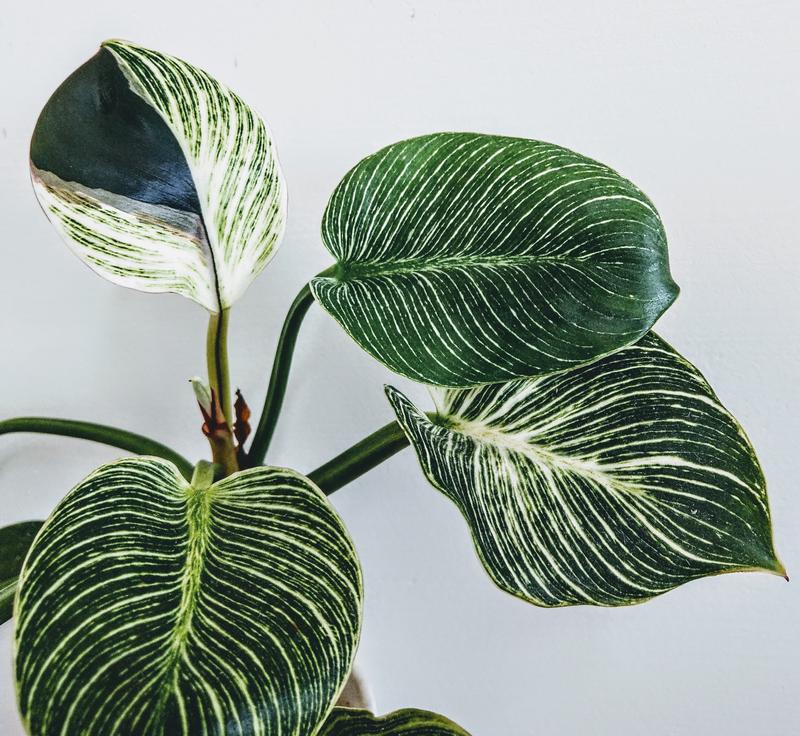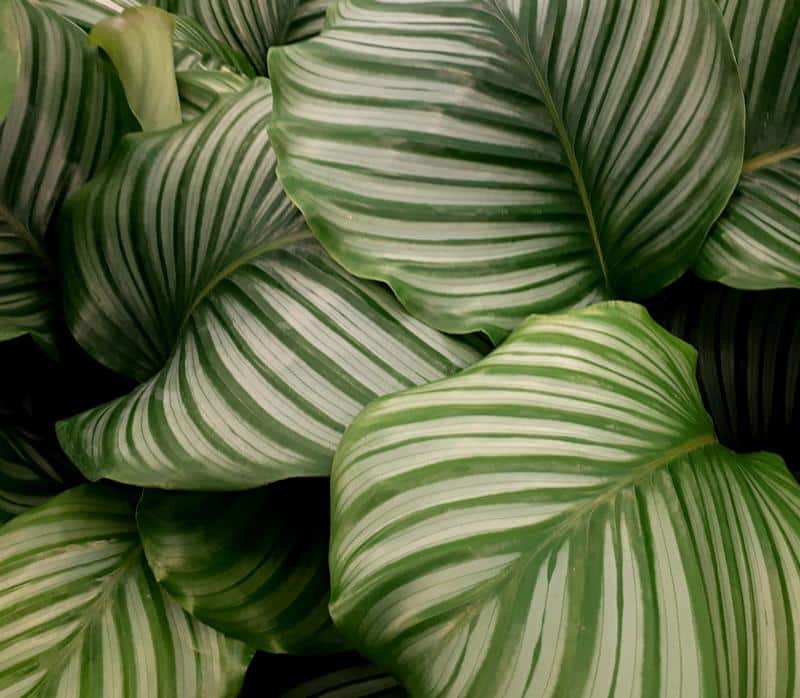Are Calathea Plants Toxic to Dogs? Is Calathea Safe for Dogs?
Are Calathea plants toxic to dogs? Is Calathea safe for dogs? In this article, we’ll teach you all you need to know about if Calathea is poisonous to dogs and what to do if your dog ate Calathea already. We’re then going to explain the two commands that will ensure your dog behaves around Calathea and other potentially toxic plants.
Next, we’ll go over more you should know about Calathea and dogs, such as how to keep dogs away from Calathea using barriers and other methods. Finally, we’ll finish up by instructing you on Calathea care (flowering, light requirements, watering, care indoor/outdoor, benefits, meaning) and more to know when you have dogs. Keep reading!
Are Calathea Plants Toxic to Dogs?

Calathea plants are not toxic to dogs. These stunning plants, often adorned with beautifully patterned leaves, can be safely kept in homes with pets. However, as with any indoor plant, it’s always a good idea to implement training commands to ensure your dog doesn’t develop a chewing habit.
Is Calathea Poisonous to Dogs?
Calathea is not poisonous to dogs. While the plant is non-toxic, it’s still important to note that if a dog consumes large quantities, it can lead to mild digestive upset. You should also discourage your dog from getting into the habit of eating plants, as some of them actually will be harmful.
Train the “Leave It” Command
Training your dog to obey the “Leave It” command can be invaluable when you have houseplants like Calathea. To do this:
- Hold a treat in your closed hand and let your dog sniff it.
- Say “Leave it” and wait for the dog to back away. Once they do, praise them and offer a different treat from your other hand.
- Repeat this exercise, increasing the duration and challenges, such as placing the treat on the ground and covering it with your foot.
Using this command ensures that your dog learns to avoid the plant, reducing the risk of them chewing on it, even if it’s safe.
Train the “Drop It” Command
The “Drop It” command can be equally beneficial, especially if you catch your dog in the act of chewing something they shouldn’t. Here’s how to train:
- Play a game of tug with a toy. Once your dog is tugging, say “Drop it”.
- Offer a treat near their nose. They’ll likely release the toy to get the treat. Praise them once they do.
- Return the toy, allowing play to resume. This ensures the dog doesn’t associate “Drop it” with ending the fun.
These commands will keep your dog safe around Calathea and other plants, but it’s important to remember that the underlying behavioral issues (curiosity, anxiety, boredom, etc.) that were causing all of this to begin with will still be present. And until you address those, any positive changes you see are only going to be temporary.
“Well, how do I make these changes last?”
By getting your dog to truly choose to follow your direction, that’s how. I tried many times to write out how you can do that before deciding it made more sense to just link you to the free video series that explains it better than I’d ever be able to.
The series is by a man named Dan who is one of the world’s leading dog obedience trainers. In it, he teaches you how to put an end to things like your dog chewing on your Calathea and all other misbehavior using his fast and easy-to-follow methods.
In the first video, Dan will reveal to you why the two most common methods of dog training only doom you to failure. You can watch the video now by clicking here. Follow the proven system he’ll show you in his series and you’ll never have to spend another second worrying about your dog eating Calathea ever again!
Is Calathea Safe for Dogs?

Calathea is safe for dogs. These tropical plants, with their vibrant and patterned foliage, add a touch of nature to our homes without posing a health risk to our furry friends. Nevertheless, it’s best to understand what to do if your dog shows an interest in the plant and how to discourage such behavior.
My Dog Ate My Calathea, What Do I Do?
Firstly, don’t panic. Since Calathea plants are not toxic to dogs, it won’t harm them if ingested. However, eating any plant in large amounts can cause mild stomach discomfort in dogs due to the plant fibers. If your dog ate only a small portion, they’ll likely be fine.
But if you notice any unusual behavior like excessive drooling, vomiting, or diarrhea, it’s a good idea to consult with your veterinarian to ensure your dog’s well-being.
Dog Eating Calathea: How to Prevent
To prevent your dog eating Calathea or any other houseplants:
- Place the plant in an area that’s less accessible to your dog, such as on a high shelf or in a room where the dog isn’t allowed.
- Use deterrent sprays, which are bitter-tasting and discourage dogs from chewing on the treated areas.
- Provide ample chew toys and play opportunities to distract your dog and fulfill their chewing needs.
Dogs are curious creatures, and sometimes their interest in plants stems from boredom, so ensuring they have plenty of engagement is a good idea. Training them on the “Leave It” and “Drop It” commands will also be very helpful. Learn how to do both in the first section now.
What Attracts Dogs to Calathea?
The attraction to Calathea can be due to various reasons. The movement of the leaves, which tend to “dance” in a daily light-to-dark rhythm, might intrigue some dogs. The plant’s earthy aroma might also be intriguing for some dogs, especially those with a heightened sense of smell.
Furthermore, puppies or younger dogs, who are generally more curious and teething, might be drawn to the plant’s soft leaves as a potential chew toy.
While Calatheas are safe for dogs, it’s wise for pet owners to be proactive in ensuring their plants remain undamaged and their pets stay out of mischief. Using preventive measures (learn how in the first section) and understanding the potential attraction can help maintain a harmonious home.
You should get this taken care of right away, as it will also keep your dog safe around other types of plants. You then won’t have to stress about things like are Bromeliads toxic to dogs, is Chinese Fan Palm toxic to dogs, is Stromanthe Triostar toxic to dogs, or are Prayer Plants toxic to dogs.
Calathea and Dogs

Calathea and dogs can coexist peacefully in a home setting. While Calathea plants are not toxic to dogs, it’s still preferable to prevent any unwanted chewing or digging incidents. Understanding how to keep our pets away from these plants ensures that both the plants and pets remain safe and happy.
How to Keep Dogs Away From Calathea
Keeping dogs away from your beloved Calathea plants is essential to maintain their pristine condition and prevent potential digestive upsets in dogs, even if non-toxic. Here are some methods:
- Barriers: Use physical barriers like decorative fences, plant cages, or elevated plant stands to make it difficult for your dog to reach the plant.
- Deterrent Sprays: As mentioned earlier, there are pet-safe sprays available in pet stores that taste bitter. Spraying this on the leaves can deter a dog from nibbling.
- Strategic Placement: Simply placing the plant in an area where your dog doesn’t frequent or can’t access can be effective.
Understanding Dog’s Interest in Calathea
Understanding why dogs might be attracted to Calathea can help in mitigating their interest. The rhythmic movement of Calathea leaves, their aroma, or simply a dog’s innate curiosity can draw them. Young dogs or puppies might be especially intrigued due to their explorative nature and teething tendencies.
Safe Alternatives for Dogs
To divert your dog’s attention from your plants, consider introducing dog-friendly plants or toys that can be chewed on. There are many pet-safe plants that can be added to your living space without any worry. Alternatively, providing ample chew toys or engaging in play sessions can satisfy their chewing urges.
While Calathea plants are not toxic to dogs, it’s still a good idea to take preventive steps to ensure the safety of both your plants and your pet. Learn two commands you should know in the first section. Knowing what attracts dogs to Calathea and how to deter them can lead to a harmonious living environment for all.
Calathea Care

Calatheas are captivating houseplants known for their stunning foliage and rhythmic movements. While Calathea plants are not toxic to dogs, ensuring the right care is still important to help them thrive and to maintain a pet-friendly environment in your home.
Care For Calathea Plant
Calatheas hail from tropical regions, so they prefer environments that mimic their natural habitat. This means warm temperatures, high humidity, and indirect light. Keeping these conditions consistent is key to a vibrant Calathea.
Calathea Flowering
While the Calathea’s foliage is its main attraction, it can produce flowers. These blooms are often small and less noticeable compared to the leaves. They usually appear in the summer and are a sign that the plant is happy in its environment.
Calathea Light Requirements
Calatheas do best in bright, indirect light. Direct sunlight can cause the leaves to lose their vibrant patterns or even get sunburned. A shaded spot or a room with filtered sunlight is ideal.
Calathea Watering
Calatheas prefer their soil to be consistently moist but not waterlogged. It’s important to water the plant once the top inch of the soil feels dry. Overwatering can lead to root rot, so ensure the pot has proper drainage.
Calathea Indoor Care
Indoor Calatheas will appreciate a boost in humidity, especially during dry seasons. Consider placing a humidifier near the plant or placing the pot on a tray with water and pebbles. Regularly check for pests like spider mites, which can be addressed with insecticidal soap.
Calathea Plants Benefits
Beyond their beauty, Calatheas are excellent for indoor air purification. They can remove toxins like formaldehyde and benzene from the environment, contributing to a healthier living space.
Calathea Flower Meaning
Calathea flowers, though understated, symbolize a new beginning or a fresh start. Their rhythmic leaf movements, which resemble praying hands, have also associated them with spiritual themes in various cultures.
Calathea Outdoors
In warmer climates, Calatheas can be grown outdoors, but they should be placed in a shaded spot. Ensure they’re protected from direct sunlight and have a consistent water supply. If temperatures drop too low, it’s advisable to bring them indoors.
In conclusion, caring for Calatheas can be a bit demanding, but the rewards—a thriving, beautiful, and dog-safe plant—are well worth the effort. Understanding their specific needs ensures that both the plant and your pet coexist harmoniously in your living space.
Learn the two commands that will keep your dog safe around Calatheas and all other plants by going back to the first section now.
I’m sure it’s a relief to have all of your questions about Calathea and dogs answered, so I’ll let you get started now. Good luck, and thanks for reading our article “Are Calathea Plants Toxic to Dogs? Is Calathea Safe for Dogs?”





